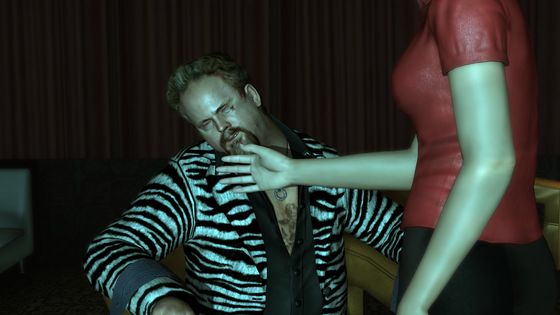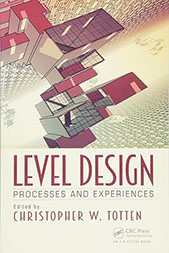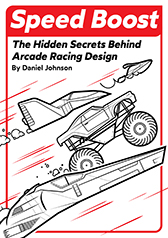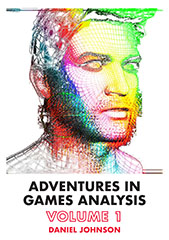Best Articles
October 22nd, 2010
A collection of my best posts can below. Some of the earlier game-specific articles tend to generalise more than I’d like, but I can say that I’m generally pleased with what I’ve written here. Please enjoy.
Collections of Posts
Super Metroid (level design, tenets and player stringing)
Heavy Rain (narrative, skill, player roles)
Resident Evil series (various design elements)
Okami (player stamina, progression and flow)
Metroid Prime 3 (play journal, level design)
Zelda: Twilight Princess (originality and structure)
GTA Series (shared journal and 3 part overview)
Syphon Filter Series (mix bag)
Quake series (nightmare, narrative, mobility and design)
Games Crunch
DP’s Games Crunch 2009 Part #2
DP’s Games Crunch 2009 Part #1
On Individual Games
Super Monkey Ball – Leading into a Banana Blitz
Differences Between House of the Dead II and III
Majora’s Mask And Cultural Alienation
Trash Panic: Causing Much Mayhem, Dropping Drama!!
The Torturous Taste of a Magnificent Neo-Retro Light Show (Geometry Wars: Retro Evolved)
Guest Writing
Link’s Crossbow Training Review (Wii)
Portal and the Deconstruction of the Institution
Editoral/Features
Exploring Jamaican Game Culture (Interview)
Marketing Stimuli, Previews and Chicken Feathers
Why You Should Buy the Original Metal Gear Solid over Metal Gear Solid: The Twin Snakes
Watch Morgan Webb Totally Degrade Video Games on the Tyra Banks Show
Five Advantages of Being a PAL Gamer
Speculating over the Original Intentions Behind the Gamecube’s Hi-Speed Port
The Best Upcoming Fan-Service Games of 2008
DP’s Retro Gaming Compilation Wishlist
The 12 Best “Non Gamer” Games for the PSP
Trailer Analysis
Resident Evil 5 PS3 Conference Trailer Breakdown
Hidden Secrets/Clues in the Resident Evil 5 Trailer
Books
Good Video Games and Good Learning Overview
An Overview of A Theory of Fun (Raph Koster)
Metal Gear Solid Novelization Break down (Part #2 Tangible Differences)
Metal Gear Solid Novelization Break down (Part #1 Impressions)
Publications
Pixel Hunt Re-examined (+ Some Words on Retroaction)
Good Game ‘Rei: The Blogosphere’ Dissection
Hyper, Print Media and Tips for Survival
Other
The Ideological Framework of Berserk
Straight-up Interactive Narrative and Quake
September 16th, 2010
I thoroughly enjoyed the narrative aspect of Quake II, in fact, I prefer its narrative language over almost everything else out there. This might sound a little strange given that Quake II is not known for its storytelling prowess, but then again, that’s entirely the point.
Coming at it from a modern perspective where macho space marines populate 5/8ths of all video game narratives, Quake II‘s premise of a one man assault on an alien planet may come off as cliché. Then again id software wrote this cliché in the video game world with an angry American storming a Nazi base (Wolfenstien 3D) and a one man assault of an alien planet (Doom)…wait a minute. This backdrop is all that’s needed though, it’s simple to understand, unobtrusive and doesn’t command a great deal of your time.
The rest of the narrative is, as it should be, interactivity-based, as follows:
- individual battles paint the picture of conflict on the Strogg homeworld
- interacting with the elevators, switches and other devices define the technological make-up of the alien race
- each level constitutes a part of the Strogg’s civil and industrial body, whether it be the mines, sewers, warehouse etc. Therefore, playing Quake II is to take a one-person tour through the interconnected life stream of the Strogg’s homeworld
- each objective is a narrative way point
- the graphical language of the grunge textures and prison-like architecture tells its own history which the player can discern for themself
- enemy movement patterns, their visual character and the grunts they make design the personality of the actors
- stealing a tank commander’s head to open a door, calling down an air-strike on a bunker, and defeating Big Gun and Makron act as set pieces
- the non-hostile human characters are minor actors
This narrative, one which uses the strengths of the medium, trusts the player enough to let them connect the dots through their own experience. For the most part, the Half-life games tick every box here too which also makes it a pretty good story, but then the director jumps on the scene and ruins the experience in one of two ways. The first by throwing a bunch of talky, “love me! love me!” characters at you which bear little relation to what the player is actually otherwise doing in the gameplay. The second is the use of blatantly scripted scenarios which attempt to be organic, but fail for all their contrivances. The scripted sequences often fail to have an effect because you’re too busy not playing the game the director intended so that you’ll organically trigger an event at the ideal moment or, as is always the case with the original game, the scripting is so glitchy that nothing will trigger and you’ll be forced to restart from your last save. Quake II is almost completely hands-off when it comes to the director, the Half-life games can’t help themselves. Furthermore, the level design in Quake II is meaningfully aids in the combat and movement mechanics, yet Half-life, particularly Half-life 2 is full of so much whitespace its disastrous.
Quake II provides the player with the appropriate context for them to mould their behaviour to and then allows them to engage in the narrative as they see fit. There’s no pretension in trying to be a blockbuster (God of War III), falsehood in limiting the player’s engagement in order to offer choice (Bioware games) or fixed sequences where someone else is trying to do the talking (Metal Gear series), it’s just straight up interactive narrative. That is, a string of encounters punctuated by moments of switch-flipping and button-pushing and for this reason, Quake II has a fantastic, if not unassuming narrative.
Additional Readings
Mapping Stroggos. – Groping the Elephant
Player Roles and Heavy Rain
July 17th, 2010

Heavy Rain‘s core conceit is the question: How far would you go for the one you love? Those who have played Heavy Rain will know that this question is most obviously evident in the trials undertaken by the lead protagonist Ethan Mars, but it’s also one which ripples into the tangled stories of the other cast members. To follow through on this question, Heavy Rain establishes relatable characters (through menial, day-to-day context) and puts them in extreme situations which are constructed to press this question. These situations bring the player’s differing roles of agency to the forefront. In many respects, these sequences create deliberation between the different parties that the player occupies, which is why players agonize over their decisions; they can’t get everyone to agree and are forced into a tough compromise. Here is breakdown of the player’s roles of agency and the respective questions asked to each player role at each trial, using Ethan as the model:
Co-author
If I were Ethan, what would I do?
(based on the player’s understanding of the avatar’s principles combined with their own)
Avatar
Within my inferred understanding of Ethan’s character, what do I think he would do?
(based on the player’s understanding of the avatar’s principles, independent of their own)
Viewer
What do I want to see happen, what is most entertaining?
(based on the player’s compulsion)
Director
What is the responsible action, the right thing to do?
(based on the player’s ethical interpretation)
When we play video games, we don’t just act upon our own whim, but rather our actions are influenced by the different ways we engage with the game. When I take the role of Solid Snake inMetal Gear Solid, I share this role with his—the avatar’s—doctrine. I know that Snake is cunning, inventive and stealthy, so my actions are mapped to my understanding of what it means in inhabit this character. I, therefore, have the freedom to act within my own interpretation of the character. This is called co-authorship.
The avatar is also their own character, so they can exist independently of the player. As mentioned in the previous article, there are times when we are not in control of the avatar. For instance, in cut scenes. In these instances the avatar is in their own frame of mind, without our influence, which affects how we think respond to the second question. Another way to think of this is, “if there was a cut scene here, what would the avatar most likely do?”
Different types of games emphasize different roles. Open world action games such as Just Cause 2or Saints Row often feature “empty” avatars or at the very least avatars bent on fun and mayhem, because these games are viewer-centric. That is, the player’s actions are based around whatever seems fun or entertaining. Injecting prescribed character into these avatars works against the impetus of enjoyment as it supposes the player model their behavior around the predefined persona of the avatar. This was apparent in Grand Theft Auto IV, where some players felt uncomfortable with simulating the murder and destruction which the previous GTA games reveled in. Because Niko was a responsible, good-willed avatar such actions would contradict his innocent persona.
The director is the Jiminy Cricket-esque conscience which puts ethical considerations into focus. Normally, most games are ethically sound, but occasional titles, like Heavy Rain, force the player into moments of moral and ethical deliberation. It’s here where we must consider our role as the director of the experience.
All character-based games feature co-authorship and the avatar’s prescribed perspective. In video games the player needs a body to inhibit and a base level persona to model their behavior on; these are basic requisites that determine play. The presence of the other two roles depends on the subject matter of the game. What is most fascinating about Heavy Rain is the way these moments make the player conscious of their multiple identities within the interactive medium. We’re not just making one choice, we’re making many and under pressure.




 Game Design Companion: A Critical Analysis of Wario Land 4 - $7.99
Game Design Companion: A Critical Analysis of Wario Land 4 - $7.99 Level Design: Processes and Experiences
Level Design: Processes and Experiences Speed Boost: The Hidden Secrets Behind Arcade Racing Design - $5.99
Speed Boost: The Hidden Secrets Behind Arcade Racing Design - $5.99 Adventures in Games Analysis: Volume I - $5.99
Adventures in Games Analysis: Volume I - $5.99







